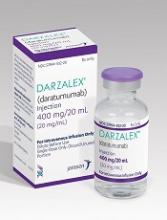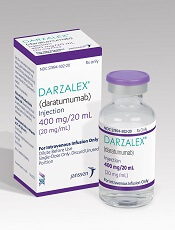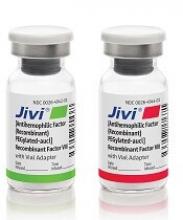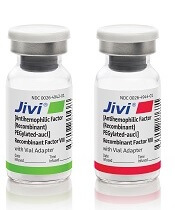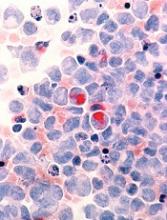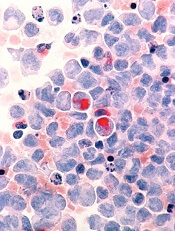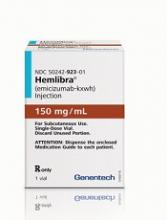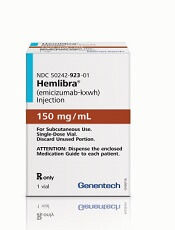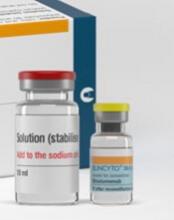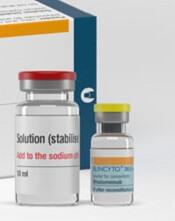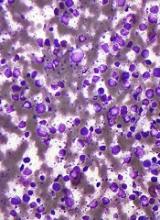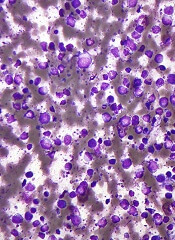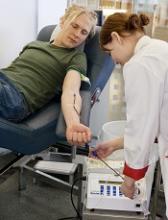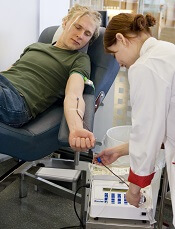User login
Daratumumab approved for new indication in MM
The European Commission (EC) has approved a new indication for daratumumab (Darzalex®).
The drug is now authorized for use in combination with bortezomib, melphalan, and prednisone (VMP) to treat adults with newly diagnosed multiple myeloma (MM) who are ineligible for autologous stem cell transplant.
Daratumumab was previously approved by the EC for use in combination with lenalidomide and dexamethasone, or bortezomib and dexamethasone, to treat adults with MM who have received at least one prior therapy.
In addition, daratumumab is EC-approved as monotherapy for adults with relapsed and refractory MM whose prior therapy included a proteasome inhibitor and an immunomodulatory agent and who have demonstrated disease progression on their last therapy.
The EC’s latest approval for daratumumab is based on results from the phase 3 ALCYONE (MMY3007) study.
Results from this study were presented at the 2017 ASH Annual Meeting and simultaneously published in The New England Journal of Medicine.
ALCYONE enrolled 706 patients with newly diagnosed MM who were not eligible for high-dose chemotherapy with autologous stem cell transplant. Patients were randomized to receive VMP or daratumumab plus VMP (D-VMP).
The overall response rates were 91% in the D-VMP arm and 74% in the VMP arm (P<0.0001). Rates of complete response were 43% and 24%, respectively. Rates of minimal residual disease negativity were 22% and 6%, respectively.
The median progression-free survival (PFS) was not reached in the D-VMP arm and was 18.1 months in the VMP arm. The 12-month PFS was 87% and 76%, respectively. The 18-month PFS was 72% and 50%, respectively.
The most common treatment-emergent adverse events (in the D-VMP and VMP arms, respectively) were neutropenia (50% and 53%), thrombocytopenia (49% and 54%), anemia (28% and 38%), peripheral sensory neuropathy (28% and 34%), upper respiratory tract infection (26% and 14%), diarrhea (24% and 25%), pyrexia (23% and 21%), and nausea (21% and 22%).
Infusion-related reactions occurred in 28% of patients in the D-VMP arm and 0% of those in the VMP arm.
The rate of grade 3/4 infections was higher in the D-VMP arm than the VMP arm—23% and 15%, respectively. In both arms, most infections resolved.
The most common grade 3/4 treatment-emergent adverse events (in the D-VMP and VMP arms, respectively) were neutropenia (40% and 39%), thrombocytopenia (34% and 38%), and anemia (16% and 20%).
The rate of discontinuation due to adverse events was 5% in the D-VMP arm and 9% in the VMP arm.
The European Commission (EC) has approved a new indication for daratumumab (Darzalex®).
The drug is now authorized for use in combination with bortezomib, melphalan, and prednisone (VMP) to treat adults with newly diagnosed multiple myeloma (MM) who are ineligible for autologous stem cell transplant.
Daratumumab was previously approved by the EC for use in combination with lenalidomide and dexamethasone, or bortezomib and dexamethasone, to treat adults with MM who have received at least one prior therapy.
In addition, daratumumab is EC-approved as monotherapy for adults with relapsed and refractory MM whose prior therapy included a proteasome inhibitor and an immunomodulatory agent and who have demonstrated disease progression on their last therapy.
The EC’s latest approval for daratumumab is based on results from the phase 3 ALCYONE (MMY3007) study.
Results from this study were presented at the 2017 ASH Annual Meeting and simultaneously published in The New England Journal of Medicine.
ALCYONE enrolled 706 patients with newly diagnosed MM who were not eligible for high-dose chemotherapy with autologous stem cell transplant. Patients were randomized to receive VMP or daratumumab plus VMP (D-VMP).
The overall response rates were 91% in the D-VMP arm and 74% in the VMP arm (P<0.0001). Rates of complete response were 43% and 24%, respectively. Rates of minimal residual disease negativity were 22% and 6%, respectively.
The median progression-free survival (PFS) was not reached in the D-VMP arm and was 18.1 months in the VMP arm. The 12-month PFS was 87% and 76%, respectively. The 18-month PFS was 72% and 50%, respectively.
The most common treatment-emergent adverse events (in the D-VMP and VMP arms, respectively) were neutropenia (50% and 53%), thrombocytopenia (49% and 54%), anemia (28% and 38%), peripheral sensory neuropathy (28% and 34%), upper respiratory tract infection (26% and 14%), diarrhea (24% and 25%), pyrexia (23% and 21%), and nausea (21% and 22%).
Infusion-related reactions occurred in 28% of patients in the D-VMP arm and 0% of those in the VMP arm.
The rate of grade 3/4 infections was higher in the D-VMP arm than the VMP arm—23% and 15%, respectively. In both arms, most infections resolved.
The most common grade 3/4 treatment-emergent adverse events (in the D-VMP and VMP arms, respectively) were neutropenia (40% and 39%), thrombocytopenia (34% and 38%), and anemia (16% and 20%).
The rate of discontinuation due to adverse events was 5% in the D-VMP arm and 9% in the VMP arm.
The European Commission (EC) has approved a new indication for daratumumab (Darzalex®).
The drug is now authorized for use in combination with bortezomib, melphalan, and prednisone (VMP) to treat adults with newly diagnosed multiple myeloma (MM) who are ineligible for autologous stem cell transplant.
Daratumumab was previously approved by the EC for use in combination with lenalidomide and dexamethasone, or bortezomib and dexamethasone, to treat adults with MM who have received at least one prior therapy.
In addition, daratumumab is EC-approved as monotherapy for adults with relapsed and refractory MM whose prior therapy included a proteasome inhibitor and an immunomodulatory agent and who have demonstrated disease progression on their last therapy.
The EC’s latest approval for daratumumab is based on results from the phase 3 ALCYONE (MMY3007) study.
Results from this study were presented at the 2017 ASH Annual Meeting and simultaneously published in The New England Journal of Medicine.
ALCYONE enrolled 706 patients with newly diagnosed MM who were not eligible for high-dose chemotherapy with autologous stem cell transplant. Patients were randomized to receive VMP or daratumumab plus VMP (D-VMP).
The overall response rates were 91% in the D-VMP arm and 74% in the VMP arm (P<0.0001). Rates of complete response were 43% and 24%, respectively. Rates of minimal residual disease negativity were 22% and 6%, respectively.
The median progression-free survival (PFS) was not reached in the D-VMP arm and was 18.1 months in the VMP arm. The 12-month PFS was 87% and 76%, respectively. The 18-month PFS was 72% and 50%, respectively.
The most common treatment-emergent adverse events (in the D-VMP and VMP arms, respectively) were neutropenia (50% and 53%), thrombocytopenia (49% and 54%), anemia (28% and 38%), peripheral sensory neuropathy (28% and 34%), upper respiratory tract infection (26% and 14%), diarrhea (24% and 25%), pyrexia (23% and 21%), and nausea (21% and 22%).
Infusion-related reactions occurred in 28% of patients in the D-VMP arm and 0% of those in the VMP arm.
The rate of grade 3/4 infections was higher in the D-VMP arm than the VMP arm—23% and 15%, respectively. In both arms, most infections resolved.
The most common grade 3/4 treatment-emergent adverse events (in the D-VMP and VMP arms, respectively) were neutropenia (40% and 39%), thrombocytopenia (34% and 38%), and anemia (16% and 20%).
The rate of discontinuation due to adverse events was 5% in the D-VMP arm and 9% in the VMP arm.
Factor VIII product approved for hemophilia A
The US Food and Drug Administration (FDA) has approved Jivi® (antihemophilic factor [recombinant] PEGylated-aucl) for the treatment of hemophilia A.
Jivi (formerly BAY94-9027) is a DNA-derived, factor VIII concentrate approved for use in previously treated adults and adolescents (age 12 and older) with hemophilia A.
The product is approved for on-demand treatment and control of bleeding episodes, for perioperative management of bleeding, and as routine prophylaxis to reduce the frequency of bleeding episodes.
The initial recommended prophylactic regimen is dosing twice weekly (30-40 IU/kg) with the ability to dose every 5 days (45-60 IU/kg) and further individually adjust to less or more frequent dosing based on bleeding episodes.
The FDA’s approval of Jivi is based on results from the phase 2/3 PROTECT VIII trial. Some results from this trial were published in the Journal of Thrombosis and Haemostasis in 2016. Additional results are available in the prescribing information for Jivi.
PROTECT VIII enrolled previously treated adults and adolescents (ages 12 to 65) with severe hemophilia A.
In part A, researchers evaluated different dosing regimens for Jivi used as prophylaxis and on-demand treatment. An optional extension study was available to patients who completed part A.
In part B, researchers evaluated Jivi for perioperative management.
Efficacy
In part A, there were 132 patients in the intent‐to‐treat population—112 in the prophylaxis group and 20 in the on-demand group.
Patients received Jivi for 36 weeks. For the first 10 weeks, patients in the prophylaxis group received twice-weekly dosing at 25 IU/kg.
Patients with more than one bleed during this time went on to receive 30–40 IU/kg twice weekly. Patients with one or fewer bleeds were eligible for randomization to dosing every 5 days (45–60 IU/kg) or every 7 days (60 IU/kg).
The median annualized bleeding rate (ABR) was 4.1 for the patients who were treated twice weekly and were not eligible for randomization (n=13) and 1.9 for patients who were eligible for randomization but continued on twice-weekly treatment (n=11).
The median ABR was 1.9 for patients who were randomized to treatment every 5 days (n=43) and 0.96 for patients who completed prophylaxis with dosing every 7 days (32/43).
The median ABR for patients treated on demand was 24.1.
There were 388 treated bleeds in the on-demand group and 317 treated bleeds in the prophylaxis group. Overall, 73.3% of responses to treatment were considered “excellent” or “good,” 23.3% were considered “moderate,” and 3.3% were considered “poor.”
There were 17 patients who underwent 20 major surgeries in part B or the extension study and 10 patients who underwent minor surgeries in part A. Jivi provided “good” or “excellent” hemostatic control during all surgeries.
Safety
Safety data are available for 148 patients age 12 and older.
Adverse events in these patients included abdominal pain (3%), nausea (5%), vomiting (3%), injection site reactions (1%), pyrexia (5%), hypersensitivity (2%), dizziness (2%), headache (14%), insomnia (3%), cough (7%), erythema (1%), pruritus (1%), rash (2%), and flushing (1%).
A factor VIII inhibitor was reported in one adult patient, but repeat testing did not confirm the report.
One adult with asthma had a clinical hypersensitivity reaction and a transient increase of IgM anti-PEG antibody titer, which was negative upon retesting.
The US Food and Drug Administration (FDA) has approved Jivi® (antihemophilic factor [recombinant] PEGylated-aucl) for the treatment of hemophilia A.
Jivi (formerly BAY94-9027) is a DNA-derived, factor VIII concentrate approved for use in previously treated adults and adolescents (age 12 and older) with hemophilia A.
The product is approved for on-demand treatment and control of bleeding episodes, for perioperative management of bleeding, and as routine prophylaxis to reduce the frequency of bleeding episodes.
The initial recommended prophylactic regimen is dosing twice weekly (30-40 IU/kg) with the ability to dose every 5 days (45-60 IU/kg) and further individually adjust to less or more frequent dosing based on bleeding episodes.
The FDA’s approval of Jivi is based on results from the phase 2/3 PROTECT VIII trial. Some results from this trial were published in the Journal of Thrombosis and Haemostasis in 2016. Additional results are available in the prescribing information for Jivi.
PROTECT VIII enrolled previously treated adults and adolescents (ages 12 to 65) with severe hemophilia A.
In part A, researchers evaluated different dosing regimens for Jivi used as prophylaxis and on-demand treatment. An optional extension study was available to patients who completed part A.
In part B, researchers evaluated Jivi for perioperative management.
Efficacy
In part A, there were 132 patients in the intent‐to‐treat population—112 in the prophylaxis group and 20 in the on-demand group.
Patients received Jivi for 36 weeks. For the first 10 weeks, patients in the prophylaxis group received twice-weekly dosing at 25 IU/kg.
Patients with more than one bleed during this time went on to receive 30–40 IU/kg twice weekly. Patients with one or fewer bleeds were eligible for randomization to dosing every 5 days (45–60 IU/kg) or every 7 days (60 IU/kg).
The median annualized bleeding rate (ABR) was 4.1 for the patients who were treated twice weekly and were not eligible for randomization (n=13) and 1.9 for patients who were eligible for randomization but continued on twice-weekly treatment (n=11).
The median ABR was 1.9 for patients who were randomized to treatment every 5 days (n=43) and 0.96 for patients who completed prophylaxis with dosing every 7 days (32/43).
The median ABR for patients treated on demand was 24.1.
There were 388 treated bleeds in the on-demand group and 317 treated bleeds in the prophylaxis group. Overall, 73.3% of responses to treatment were considered “excellent” or “good,” 23.3% were considered “moderate,” and 3.3% were considered “poor.”
There were 17 patients who underwent 20 major surgeries in part B or the extension study and 10 patients who underwent minor surgeries in part A. Jivi provided “good” or “excellent” hemostatic control during all surgeries.
Safety
Safety data are available for 148 patients age 12 and older.
Adverse events in these patients included abdominal pain (3%), nausea (5%), vomiting (3%), injection site reactions (1%), pyrexia (5%), hypersensitivity (2%), dizziness (2%), headache (14%), insomnia (3%), cough (7%), erythema (1%), pruritus (1%), rash (2%), and flushing (1%).
A factor VIII inhibitor was reported in one adult patient, but repeat testing did not confirm the report.
One adult with asthma had a clinical hypersensitivity reaction and a transient increase of IgM anti-PEG antibody titer, which was negative upon retesting.
The US Food and Drug Administration (FDA) has approved Jivi® (antihemophilic factor [recombinant] PEGylated-aucl) for the treatment of hemophilia A.
Jivi (formerly BAY94-9027) is a DNA-derived, factor VIII concentrate approved for use in previously treated adults and adolescents (age 12 and older) with hemophilia A.
The product is approved for on-demand treatment and control of bleeding episodes, for perioperative management of bleeding, and as routine prophylaxis to reduce the frequency of bleeding episodes.
The initial recommended prophylactic regimen is dosing twice weekly (30-40 IU/kg) with the ability to dose every 5 days (45-60 IU/kg) and further individually adjust to less or more frequent dosing based on bleeding episodes.
The FDA’s approval of Jivi is based on results from the phase 2/3 PROTECT VIII trial. Some results from this trial were published in the Journal of Thrombosis and Haemostasis in 2016. Additional results are available in the prescribing information for Jivi.
PROTECT VIII enrolled previously treated adults and adolescents (ages 12 to 65) with severe hemophilia A.
In part A, researchers evaluated different dosing regimens for Jivi used as prophylaxis and on-demand treatment. An optional extension study was available to patients who completed part A.
In part B, researchers evaluated Jivi for perioperative management.
Efficacy
In part A, there were 132 patients in the intent‐to‐treat population—112 in the prophylaxis group and 20 in the on-demand group.
Patients received Jivi for 36 weeks. For the first 10 weeks, patients in the prophylaxis group received twice-weekly dosing at 25 IU/kg.
Patients with more than one bleed during this time went on to receive 30–40 IU/kg twice weekly. Patients with one or fewer bleeds were eligible for randomization to dosing every 5 days (45–60 IU/kg) or every 7 days (60 IU/kg).
The median annualized bleeding rate (ABR) was 4.1 for the patients who were treated twice weekly and were not eligible for randomization (n=13) and 1.9 for patients who were eligible for randomization but continued on twice-weekly treatment (n=11).
The median ABR was 1.9 for patients who were randomized to treatment every 5 days (n=43) and 0.96 for patients who completed prophylaxis with dosing every 7 days (32/43).
The median ABR for patients treated on demand was 24.1.
There were 388 treated bleeds in the on-demand group and 317 treated bleeds in the prophylaxis group. Overall, 73.3% of responses to treatment were considered “excellent” or “good,” 23.3% were considered “moderate,” and 3.3% were considered “poor.”
There were 17 patients who underwent 20 major surgeries in part B or the extension study and 10 patients who underwent minor surgeries in part A. Jivi provided “good” or “excellent” hemostatic control during all surgeries.
Safety
Safety data are available for 148 patients age 12 and older.
Adverse events in these patients included abdominal pain (3%), nausea (5%), vomiting (3%), injection site reactions (1%), pyrexia (5%), hypersensitivity (2%), dizziness (2%), headache (14%), insomnia (3%), cough (7%), erythema (1%), pruritus (1%), rash (2%), and flushing (1%).
A factor VIII inhibitor was reported in one adult patient, but repeat testing did not confirm the report.
One adult with asthma had a clinical hypersensitivity reaction and a transient increase of IgM anti-PEG antibody titer, which was negative upon retesting.
PLK1 inhibitor receives orphan designation for AML
The European Commission has granted orphan drug designation to onvansertib for the treatment of acute myeloid leukemia (AML).
Onvansertib (formerly PCM-075) is an oral adenosine triphosphate competitive inhibitor of the serine/threonine Polo-like kinase 1 (PLK1) enzyme, which is overexpressed in hematologic and solid tumor malignancies.
Trovagene, Inc., the company developing onvansertib, said the drug has a 24-hour half-life with reversible, on-target hematologic activity.
These factors, combined with an improved dose/scheduling protocol, could mean onvansertib will improve upon long-term outcomes observed in previous studies with a PLK inhibitor in AML.
This includes a phase 2 study in which AML patients who received a PLK inhibitor plus low-dose cytarabine (LDAC) had a higher response rate than patients who received LDAC alone—31% and 13.3%, respectively.
Trovagene said preclinical studies have shown that onvansertib synergizes with more than 10 drugs used to treat hematologic and solid tumor malignancies. This includes FLT3 and HDAC inhibitors, taxanes, and cytotoxins.
Trovagene is now conducting a phase 1b/2 trial of onvansertib in combination with standard care (LDAC or decitabine) in patients with AML (NCT03303339).
The company has already completed a phase 1 dose-escalation study of onvansertib in patients with advanced metastatic solid tumor malignancies. Results from this study were published in Investigational New Drugs.
About orphan designation
Orphan drug designation in Europe is available to companies developing products intended to treat a life-threatening or chronically debilitating condition that affects fewer than 5 in 10,000 people in the European Union (EU).
The designation allows for financial and regulatory incentives that include 10 years of marketing exclusivity in the EU after product approval, eligibility for conditional marketing authorization, protocol assistance from the European Medicines Agency at reduced fees during the product development phase, and direct access to centralized marketing authorization in the EU.
The European Commission has granted orphan drug designation to onvansertib for the treatment of acute myeloid leukemia (AML).
Onvansertib (formerly PCM-075) is an oral adenosine triphosphate competitive inhibitor of the serine/threonine Polo-like kinase 1 (PLK1) enzyme, which is overexpressed in hematologic and solid tumor malignancies.
Trovagene, Inc., the company developing onvansertib, said the drug has a 24-hour half-life with reversible, on-target hematologic activity.
These factors, combined with an improved dose/scheduling protocol, could mean onvansertib will improve upon long-term outcomes observed in previous studies with a PLK inhibitor in AML.
This includes a phase 2 study in which AML patients who received a PLK inhibitor plus low-dose cytarabine (LDAC) had a higher response rate than patients who received LDAC alone—31% and 13.3%, respectively.
Trovagene said preclinical studies have shown that onvansertib synergizes with more than 10 drugs used to treat hematologic and solid tumor malignancies. This includes FLT3 and HDAC inhibitors, taxanes, and cytotoxins.
Trovagene is now conducting a phase 1b/2 trial of onvansertib in combination with standard care (LDAC or decitabine) in patients with AML (NCT03303339).
The company has already completed a phase 1 dose-escalation study of onvansertib in patients with advanced metastatic solid tumor malignancies. Results from this study were published in Investigational New Drugs.
About orphan designation
Orphan drug designation in Europe is available to companies developing products intended to treat a life-threatening or chronically debilitating condition that affects fewer than 5 in 10,000 people in the European Union (EU).
The designation allows for financial and regulatory incentives that include 10 years of marketing exclusivity in the EU after product approval, eligibility for conditional marketing authorization, protocol assistance from the European Medicines Agency at reduced fees during the product development phase, and direct access to centralized marketing authorization in the EU.
The European Commission has granted orphan drug designation to onvansertib for the treatment of acute myeloid leukemia (AML).
Onvansertib (formerly PCM-075) is an oral adenosine triphosphate competitive inhibitor of the serine/threonine Polo-like kinase 1 (PLK1) enzyme, which is overexpressed in hematologic and solid tumor malignancies.
Trovagene, Inc., the company developing onvansertib, said the drug has a 24-hour half-life with reversible, on-target hematologic activity.
These factors, combined with an improved dose/scheduling protocol, could mean onvansertib will improve upon long-term outcomes observed in previous studies with a PLK inhibitor in AML.
This includes a phase 2 study in which AML patients who received a PLK inhibitor plus low-dose cytarabine (LDAC) had a higher response rate than patients who received LDAC alone—31% and 13.3%, respectively.
Trovagene said preclinical studies have shown that onvansertib synergizes with more than 10 drugs used to treat hematologic and solid tumor malignancies. This includes FLT3 and HDAC inhibitors, taxanes, and cytotoxins.
Trovagene is now conducting a phase 1b/2 trial of onvansertib in combination with standard care (LDAC or decitabine) in patients with AML (NCT03303339).
The company has already completed a phase 1 dose-escalation study of onvansertib in patients with advanced metastatic solid tumor malignancies. Results from this study were published in Investigational New Drugs.
About orphan designation
Orphan drug designation in Europe is available to companies developing products intended to treat a life-threatening or chronically debilitating condition that affects fewer than 5 in 10,000 people in the European Union (EU).
The designation allows for financial and regulatory incentives that include 10 years of marketing exclusivity in the EU after product approval, eligibility for conditional marketing authorization, protocol assistance from the European Medicines Agency at reduced fees during the product development phase, and direct access to centralized marketing authorization in the EU.
A new standard of care in hemophilia A?
Results of a phase 3 trial showed that prophylaxis with emicizumab significantly reduced bleeds, compared to no prophylaxis, in patients with hemophilia A without inhibitors.
Emicizumab also reduced bleeds when compared to prior factor VIII prophylaxis.
The most common adverse events (AEs) in this trial were injection site reactions, arthralgia, nasopharyngitis, headache, upper respiratory tract infection, and influenza.
Johnny Mahlangu, MBBCh, of the University of the Witwatersrand and NHLS in Johannesburg, South Africa, and his colleagues reported these results, from the HAVEN 3 trial, in NEJM.
The trial was sponsored by F. Hoffmann–La Roche and Chugai Pharmaceutical.
“In the HAVEN 3 study, [emicizumab] showed a significant and clinically meaningful reduction in bleeds in people with hemophilia A without factor VIII inhibitors, while offering multiple subcutaneous dosing options,” Dr. Mahlangu said.
“The publication of these results . . . represents a major advance for hemophilia research and reinforces the potential of [emicizumab] to change the standard of care for people with hemophilia A.”
HAVEN 3 included 152 patients with hemophilia A (age 12 and older) who were previously treated with factor VIII therapy either on-demand or for prophylaxis.
Patients previously treated with on-demand factor VIII were randomized in a 2:2:1 fashion to receive:
- Emicizumab prophylaxis at 3 mg/kg/wk for 4 weeks, followed by 1.5 mg/kg/wk for at least 24 weeks (arm A)
- Emicizumab prophylaxis at 3 mg/kg/wk for 4 weeks, followed by 3 mg/kg/2wks for at least 24 weeks (arm B)
- No prophylaxis for at least 24 weeks (arm C).
Patients previously treated with factor VIII prophylaxis received emicizumab prophylaxis at 3 mg/kg/wk for 4 weeks, followed by 1.5 mg/kg/wk until the end of study (arm D).
Episodic treatment of breakthrough bleeds with factor VIII therapy was allowed per protocol.
Efficacy
Emicizumab reduced treated bleeds by 96% (rate ratio [RR]=0.04; P<0.0001) when given every week and 97% (RR=0.03; P<0.001) when given every 2 weeks, compared to no prophylaxis. The annualized bleeding rate (ABR) was 1.5, 1.3, and 38.2, respectively.
Emicizumab reduced all bleeds by 95% (RR=0.05; P<0.001) when given every week and 94% (RR=0.06; P<0.001) when given every 2 weeks, compared to no prophylaxis. The ABR was 2.5, 2.6, and 47.6, respectively.
There were zero treated bleeds in 55.6% of patients who received emicizumab every week and 60% of patients who received emicizumab every 2 weeks, compared to 0% of patients who did not receive prophylaxis.
In an intra-patient comparison of people who previously received factor VIII prophylaxis in a prospective non-interventional study and switched to emicizumab prophylaxis, emicizumab reduced treated bleeds by 68% (RR=0.32; P<0.001).
The ABR was 1.5 when patients were on emicizumab and 4.8 when they were on prior prophylaxis.
Safety
The most common AEs were injection site reactions (25%), upper respiratory tract infection (11%), nasopharyngitis (12%), arthralgia (19%), headache (11%), and influenza (6%).
One patient in group B stopped treatment due to multiple low-grade AEs considered related to emicizumab. The AEs were insomnia (grade 2), alopecia (grade 1), nightmare (grade 2), lethargy (grade 2), pruritus (grade 1), headache (grade 1), and depressed mood (grade 1).
Serious AEs included bleeding events (n=4), cardiac disorder (n=1), infection (n=3), musculoskeletal disorders (n=3), loosening of an orthopedic device (n=1), psychiatric disorder (n=1), and trauma (n=1). One patient experienced nephrolithiasis after a dose increase to 3 mg/kg/wk.
None of the serious AEs were considered related to emicizumab.
There were no deaths, cases of thrombotic microangiopathy, thrombotic events, or new cases of factor VIII inhibitors.
Two patients had detectable inhibitors at baseline, but titers declined spontaneously during the trial. Another patient had a detectable inhibitor titer at week 13 that spontaneously declined at week 25.
Results of a phase 3 trial showed that prophylaxis with emicizumab significantly reduced bleeds, compared to no prophylaxis, in patients with hemophilia A without inhibitors.
Emicizumab also reduced bleeds when compared to prior factor VIII prophylaxis.
The most common adverse events (AEs) in this trial were injection site reactions, arthralgia, nasopharyngitis, headache, upper respiratory tract infection, and influenza.
Johnny Mahlangu, MBBCh, of the University of the Witwatersrand and NHLS in Johannesburg, South Africa, and his colleagues reported these results, from the HAVEN 3 trial, in NEJM.
The trial was sponsored by F. Hoffmann–La Roche and Chugai Pharmaceutical.
“In the HAVEN 3 study, [emicizumab] showed a significant and clinically meaningful reduction in bleeds in people with hemophilia A without factor VIII inhibitors, while offering multiple subcutaneous dosing options,” Dr. Mahlangu said.
“The publication of these results . . . represents a major advance for hemophilia research and reinforces the potential of [emicizumab] to change the standard of care for people with hemophilia A.”
HAVEN 3 included 152 patients with hemophilia A (age 12 and older) who were previously treated with factor VIII therapy either on-demand or for prophylaxis.
Patients previously treated with on-demand factor VIII were randomized in a 2:2:1 fashion to receive:
- Emicizumab prophylaxis at 3 mg/kg/wk for 4 weeks, followed by 1.5 mg/kg/wk for at least 24 weeks (arm A)
- Emicizumab prophylaxis at 3 mg/kg/wk for 4 weeks, followed by 3 mg/kg/2wks for at least 24 weeks (arm B)
- No prophylaxis for at least 24 weeks (arm C).
Patients previously treated with factor VIII prophylaxis received emicizumab prophylaxis at 3 mg/kg/wk for 4 weeks, followed by 1.5 mg/kg/wk until the end of study (arm D).
Episodic treatment of breakthrough bleeds with factor VIII therapy was allowed per protocol.
Efficacy
Emicizumab reduced treated bleeds by 96% (rate ratio [RR]=0.04; P<0.0001) when given every week and 97% (RR=0.03; P<0.001) when given every 2 weeks, compared to no prophylaxis. The annualized bleeding rate (ABR) was 1.5, 1.3, and 38.2, respectively.
Emicizumab reduced all bleeds by 95% (RR=0.05; P<0.001) when given every week and 94% (RR=0.06; P<0.001) when given every 2 weeks, compared to no prophylaxis. The ABR was 2.5, 2.6, and 47.6, respectively.
There were zero treated bleeds in 55.6% of patients who received emicizumab every week and 60% of patients who received emicizumab every 2 weeks, compared to 0% of patients who did not receive prophylaxis.
In an intra-patient comparison of people who previously received factor VIII prophylaxis in a prospective non-interventional study and switched to emicizumab prophylaxis, emicizumab reduced treated bleeds by 68% (RR=0.32; P<0.001).
The ABR was 1.5 when patients were on emicizumab and 4.8 when they were on prior prophylaxis.
Safety
The most common AEs were injection site reactions (25%), upper respiratory tract infection (11%), nasopharyngitis (12%), arthralgia (19%), headache (11%), and influenza (6%).
One patient in group B stopped treatment due to multiple low-grade AEs considered related to emicizumab. The AEs were insomnia (grade 2), alopecia (grade 1), nightmare (grade 2), lethargy (grade 2), pruritus (grade 1), headache (grade 1), and depressed mood (grade 1).
Serious AEs included bleeding events (n=4), cardiac disorder (n=1), infection (n=3), musculoskeletal disorders (n=3), loosening of an orthopedic device (n=1), psychiatric disorder (n=1), and trauma (n=1). One patient experienced nephrolithiasis after a dose increase to 3 mg/kg/wk.
None of the serious AEs were considered related to emicizumab.
There were no deaths, cases of thrombotic microangiopathy, thrombotic events, or new cases of factor VIII inhibitors.
Two patients had detectable inhibitors at baseline, but titers declined spontaneously during the trial. Another patient had a detectable inhibitor titer at week 13 that spontaneously declined at week 25.
Results of a phase 3 trial showed that prophylaxis with emicizumab significantly reduced bleeds, compared to no prophylaxis, in patients with hemophilia A without inhibitors.
Emicizumab also reduced bleeds when compared to prior factor VIII prophylaxis.
The most common adverse events (AEs) in this trial were injection site reactions, arthralgia, nasopharyngitis, headache, upper respiratory tract infection, and influenza.
Johnny Mahlangu, MBBCh, of the University of the Witwatersrand and NHLS in Johannesburg, South Africa, and his colleagues reported these results, from the HAVEN 3 trial, in NEJM.
The trial was sponsored by F. Hoffmann–La Roche and Chugai Pharmaceutical.
“In the HAVEN 3 study, [emicizumab] showed a significant and clinically meaningful reduction in bleeds in people with hemophilia A without factor VIII inhibitors, while offering multiple subcutaneous dosing options,” Dr. Mahlangu said.
“The publication of these results . . . represents a major advance for hemophilia research and reinforces the potential of [emicizumab] to change the standard of care for people with hemophilia A.”
HAVEN 3 included 152 patients with hemophilia A (age 12 and older) who were previously treated with factor VIII therapy either on-demand or for prophylaxis.
Patients previously treated with on-demand factor VIII were randomized in a 2:2:1 fashion to receive:
- Emicizumab prophylaxis at 3 mg/kg/wk for 4 weeks, followed by 1.5 mg/kg/wk for at least 24 weeks (arm A)
- Emicizumab prophylaxis at 3 mg/kg/wk for 4 weeks, followed by 3 mg/kg/2wks for at least 24 weeks (arm B)
- No prophylaxis for at least 24 weeks (arm C).
Patients previously treated with factor VIII prophylaxis received emicizumab prophylaxis at 3 mg/kg/wk for 4 weeks, followed by 1.5 mg/kg/wk until the end of study (arm D).
Episodic treatment of breakthrough bleeds with factor VIII therapy was allowed per protocol.
Efficacy
Emicizumab reduced treated bleeds by 96% (rate ratio [RR]=0.04; P<0.0001) when given every week and 97% (RR=0.03; P<0.001) when given every 2 weeks, compared to no prophylaxis. The annualized bleeding rate (ABR) was 1.5, 1.3, and 38.2, respectively.
Emicizumab reduced all bleeds by 95% (RR=0.05; P<0.001) when given every week and 94% (RR=0.06; P<0.001) when given every 2 weeks, compared to no prophylaxis. The ABR was 2.5, 2.6, and 47.6, respectively.
There were zero treated bleeds in 55.6% of patients who received emicizumab every week and 60% of patients who received emicizumab every 2 weeks, compared to 0% of patients who did not receive prophylaxis.
In an intra-patient comparison of people who previously received factor VIII prophylaxis in a prospective non-interventional study and switched to emicizumab prophylaxis, emicizumab reduced treated bleeds by 68% (RR=0.32; P<0.001).
The ABR was 1.5 when patients were on emicizumab and 4.8 when they were on prior prophylaxis.
Safety
The most common AEs were injection site reactions (25%), upper respiratory tract infection (11%), nasopharyngitis (12%), arthralgia (19%), headache (11%), and influenza (6%).
One patient in group B stopped treatment due to multiple low-grade AEs considered related to emicizumab. The AEs were insomnia (grade 2), alopecia (grade 1), nightmare (grade 2), lethargy (grade 2), pruritus (grade 1), headache (grade 1), and depressed mood (grade 1).
Serious AEs included bleeding events (n=4), cardiac disorder (n=1), infection (n=3), musculoskeletal disorders (n=3), loosening of an orthopedic device (n=1), psychiatric disorder (n=1), and trauma (n=1). One patient experienced nephrolithiasis after a dose increase to 3 mg/kg/wk.
None of the serious AEs were considered related to emicizumab.
There were no deaths, cases of thrombotic microangiopathy, thrombotic events, or new cases of factor VIII inhibitors.
Two patients had detectable inhibitors at baseline, but titers declined spontaneously during the trial. Another patient had a detectable inhibitor titer at week 13 that spontaneously declined at week 25.
EC approves blinatumomab for kids
The European Commission (EC) has expanded the approved indication for blinatumomab (Blincyto®), a bispecific, CD19-directed, CD3 T-cell engager immunotherapy.
Blinatumomab is now approved as monotherapy for pediatric patients age 1 year or older who have relapsed/refractory, Philadelphia chromosome-negative, CD19-positive B-cell precursor acute lymphoblastic leukemia (ALL).
The patients must have received at least two prior therapies, or they must have relapsed after allogeneic hematopoietic stem cell transplant.
This approval of blinatumomab extends to all countries in the European Union, as well as Norway, Iceland, and Liechtenstein.
The EC previously approved blinatumomab to treat adults with Philadelphia chromosome-negative, relapsed/refractory B-cell precursor ALL.
’205 study
The EC’s approval of blinatumomab in pediatric patients is based on results from the phase 1/2 ’205 study, which were published in the Journal of Clinical Oncology in 2016.
The study included 93 pediatric patients with relapsed/refractory B-cell precursor ALL. Patients received blinatumomab as a continuous intravenous infusion—49 patients in the phase 1 portion of the trial and 44 in phase 2. The patients were followed for 2 years.
There were 4 dose-limiting toxicities (DLTs) during the phase 1 portion of the trial, and 2 DLTs were fatal. Three patients had grade 4 cytokine release syndrome (CRS), one had grade 5 cardiac failure (as well as grade 4 CRS), and one had grade 5 respiratory failure.
Recommended dose
Based on the DLTs, the maximum-tolerated dose of blinatumomab was 15 µg/m2/day, but a step-wise dosage was recommended to reduce the risk of CRS. The recommended dose was 5 μg/m2/day on days 1-7 and 15 μg/m2/day on days 8-28 for cycle 1, and 15 μg/m2/day on days 1-28 for subsequent cycles.
Dose adjustment was possible in case of adverse events (AEs). Patients who responded to blinatumomab but later relapsed had the option to be retreated with blinatumomab.
Seventy patients received at least one infusion of blinatumomab at the recommended dose. The median number of treatment cycles was 1 (range, 1 to 5).
The patients’ median age was 8 years (range, 7 months to 17 years). Forty patients (57%) had undergone allogeneic transplant prior to receiving blinatumomab, and 39 (56%) had refractory disease.
Safety
The most common AEs among patients who received the recommended dose of blinatumomab were pyrexia (80%), anemia (41%), nausea (33%), and headache (30%).
The most frequent grade 3 or higher AEs were anemia (36%), thrombocytopenia (21%), febrile neutropenia (17%), hypokalemia (17%), and neutropenia (17%).
Eight patients developed CRS. Three had grade 3 and one had grade 4 CRS.
Ten patients (14%) had treatment interruptions due to AEs, and 4 (6%) discontinued treatment permanently because of AEs.
Six patients had fatal AEs. Three died after they went on to allogeneic transplant—one of multiorgan failure, one of sepsis, and one of respiratory failure. The three other deaths were due to fungal infection, multiorgan failure, and thrombocytopenia.
Response and follow-up
Among the 70 patients who received the recommended dose of blinatumomab, 27 (39%) achieved a complete response (CR) within the first 2 cycles. Fourteen of these patients (52%) achieved minimal residual disease negativity.
Thirteen of the 27 patients (48%) who achieved a CR went on to receive an allogeneic transplant.
At the end of the 2-year follow-up, 4 of the 27 complete responders were still in remission.
Two of the patients had relapsed but were still alive, three had withdrawn consent (one in CR and two after relapse), three had died in CR after transplant, and 15 had relapsed and died.
Of the 43 patients who did not achieve a CR within the first two treatment cycles, 8 were still alive at the end of the 2-year follow-up.
The European Commission (EC) has expanded the approved indication for blinatumomab (Blincyto®), a bispecific, CD19-directed, CD3 T-cell engager immunotherapy.
Blinatumomab is now approved as monotherapy for pediatric patients age 1 year or older who have relapsed/refractory, Philadelphia chromosome-negative, CD19-positive B-cell precursor acute lymphoblastic leukemia (ALL).
The patients must have received at least two prior therapies, or they must have relapsed after allogeneic hematopoietic stem cell transplant.
This approval of blinatumomab extends to all countries in the European Union, as well as Norway, Iceland, and Liechtenstein.
The EC previously approved blinatumomab to treat adults with Philadelphia chromosome-negative, relapsed/refractory B-cell precursor ALL.
’205 study
The EC’s approval of blinatumomab in pediatric patients is based on results from the phase 1/2 ’205 study, which were published in the Journal of Clinical Oncology in 2016.
The study included 93 pediatric patients with relapsed/refractory B-cell precursor ALL. Patients received blinatumomab as a continuous intravenous infusion—49 patients in the phase 1 portion of the trial and 44 in phase 2. The patients were followed for 2 years.
There were 4 dose-limiting toxicities (DLTs) during the phase 1 portion of the trial, and 2 DLTs were fatal. Three patients had grade 4 cytokine release syndrome (CRS), one had grade 5 cardiac failure (as well as grade 4 CRS), and one had grade 5 respiratory failure.
Recommended dose
Based on the DLTs, the maximum-tolerated dose of blinatumomab was 15 µg/m2/day, but a step-wise dosage was recommended to reduce the risk of CRS. The recommended dose was 5 μg/m2/day on days 1-7 and 15 μg/m2/day on days 8-28 for cycle 1, and 15 μg/m2/day on days 1-28 for subsequent cycles.
Dose adjustment was possible in case of adverse events (AEs). Patients who responded to blinatumomab but later relapsed had the option to be retreated with blinatumomab.
Seventy patients received at least one infusion of blinatumomab at the recommended dose. The median number of treatment cycles was 1 (range, 1 to 5).
The patients’ median age was 8 years (range, 7 months to 17 years). Forty patients (57%) had undergone allogeneic transplant prior to receiving blinatumomab, and 39 (56%) had refractory disease.
Safety
The most common AEs among patients who received the recommended dose of blinatumomab were pyrexia (80%), anemia (41%), nausea (33%), and headache (30%).
The most frequent grade 3 or higher AEs were anemia (36%), thrombocytopenia (21%), febrile neutropenia (17%), hypokalemia (17%), and neutropenia (17%).
Eight patients developed CRS. Three had grade 3 and one had grade 4 CRS.
Ten patients (14%) had treatment interruptions due to AEs, and 4 (6%) discontinued treatment permanently because of AEs.
Six patients had fatal AEs. Three died after they went on to allogeneic transplant—one of multiorgan failure, one of sepsis, and one of respiratory failure. The three other deaths were due to fungal infection, multiorgan failure, and thrombocytopenia.
Response and follow-up
Among the 70 patients who received the recommended dose of blinatumomab, 27 (39%) achieved a complete response (CR) within the first 2 cycles. Fourteen of these patients (52%) achieved minimal residual disease negativity.
Thirteen of the 27 patients (48%) who achieved a CR went on to receive an allogeneic transplant.
At the end of the 2-year follow-up, 4 of the 27 complete responders were still in remission.
Two of the patients had relapsed but were still alive, three had withdrawn consent (one in CR and two after relapse), three had died in CR after transplant, and 15 had relapsed and died.
Of the 43 patients who did not achieve a CR within the first two treatment cycles, 8 were still alive at the end of the 2-year follow-up.
The European Commission (EC) has expanded the approved indication for blinatumomab (Blincyto®), a bispecific, CD19-directed, CD3 T-cell engager immunotherapy.
Blinatumomab is now approved as monotherapy for pediatric patients age 1 year or older who have relapsed/refractory, Philadelphia chromosome-negative, CD19-positive B-cell precursor acute lymphoblastic leukemia (ALL).
The patients must have received at least two prior therapies, or they must have relapsed after allogeneic hematopoietic stem cell transplant.
This approval of blinatumomab extends to all countries in the European Union, as well as Norway, Iceland, and Liechtenstein.
The EC previously approved blinatumomab to treat adults with Philadelphia chromosome-negative, relapsed/refractory B-cell precursor ALL.
’205 study
The EC’s approval of blinatumomab in pediatric patients is based on results from the phase 1/2 ’205 study, which were published in the Journal of Clinical Oncology in 2016.
The study included 93 pediatric patients with relapsed/refractory B-cell precursor ALL. Patients received blinatumomab as a continuous intravenous infusion—49 patients in the phase 1 portion of the trial and 44 in phase 2. The patients were followed for 2 years.
There were 4 dose-limiting toxicities (DLTs) during the phase 1 portion of the trial, and 2 DLTs were fatal. Three patients had grade 4 cytokine release syndrome (CRS), one had grade 5 cardiac failure (as well as grade 4 CRS), and one had grade 5 respiratory failure.
Recommended dose
Based on the DLTs, the maximum-tolerated dose of blinatumomab was 15 µg/m2/day, but a step-wise dosage was recommended to reduce the risk of CRS. The recommended dose was 5 μg/m2/day on days 1-7 and 15 μg/m2/day on days 8-28 for cycle 1, and 15 μg/m2/day on days 1-28 for subsequent cycles.
Dose adjustment was possible in case of adverse events (AEs). Patients who responded to blinatumomab but later relapsed had the option to be retreated with blinatumomab.
Seventy patients received at least one infusion of blinatumomab at the recommended dose. The median number of treatment cycles was 1 (range, 1 to 5).
The patients’ median age was 8 years (range, 7 months to 17 years). Forty patients (57%) had undergone allogeneic transplant prior to receiving blinatumomab, and 39 (56%) had refractory disease.
Safety
The most common AEs among patients who received the recommended dose of blinatumomab were pyrexia (80%), anemia (41%), nausea (33%), and headache (30%).
The most frequent grade 3 or higher AEs were anemia (36%), thrombocytopenia (21%), febrile neutropenia (17%), hypokalemia (17%), and neutropenia (17%).
Eight patients developed CRS. Three had grade 3 and one had grade 4 CRS.
Ten patients (14%) had treatment interruptions due to AEs, and 4 (6%) discontinued treatment permanently because of AEs.
Six patients had fatal AEs. Three died after they went on to allogeneic transplant—one of multiorgan failure, one of sepsis, and one of respiratory failure. The three other deaths were due to fungal infection, multiorgan failure, and thrombocytopenia.
Response and follow-up
Among the 70 patients who received the recommended dose of blinatumomab, 27 (39%) achieved a complete response (CR) within the first 2 cycles. Fourteen of these patients (52%) achieved minimal residual disease negativity.
Thirteen of the 27 patients (48%) who achieved a CR went on to receive an allogeneic transplant.
At the end of the 2-year follow-up, 4 of the 27 complete responders were still in remission.
Two of the patients had relapsed but were still alive, three had withdrawn consent (one in CR and two after relapse), three had died in CR after transplant, and 15 had relapsed and died.
Of the 43 patients who did not achieve a CR within the first two treatment cycles, 8 were still alive at the end of the 2-year follow-up.
OMS721 receives orphan designation for use in HSCT
The European Commission has granted orphan designation to OMS721 for use in the setting of hematopoietic stem cell transplant (HSCT).
OMS721 is a monoclonal antibody targeting MASP-2, the effector enzyme of the lectin pathway of the complement system.
Omeros Corporation is developing OMS721 as a treatment for HSCT-associated thrombotic microangiopathy (TMA) and other conditions.
OMS721 is currently under evaluation in a phase 2 trial (NCT02222545) of patients with HSCT-TMA, and Omeros released some results from this study in February.
Results were reported for 18 adults with HSCT-TMA persisting for at least 2 weeks following immunosuppressive regimen modification or more than 30 days post-transplant.
The patients received weekly OMS721 treatments for 4 to 8 weeks at the discretion of the investigator.
These patients had a significantly longer median overall survival than historical controls—347 days and 21 days, respectively (P<0.0001).
Omeros also reported that markers of TMA activity significantly improved following OMS721 treatment.
The mean platelet count increased from 18,100 x 106/mL at baseline to 52,300 x 106/mL (P=0.017). The mean LDH decreased from 591 U/L to 250 U/L (P<0.001). And the mean haptoglobin increased from 8 mg/dL to 141 mg/dL (P=0.003).
Mean creatinine remained stable—at approximately 120 μmol/L—but a majority of patients had co-existing conditions for which they were receiving nephrotoxic medications. These conditions included graft-versus-host disease, cytomegalovirus and human herpes virus 6 infections, prior sepsis, diffuse alveolar hemorrhage, and residual underlying malignancies.
The most commonly reported adverse events in this trial were diarrhea and neutropenia.
Four deaths occurred. One of these—due to acute renal and respiratory failure—was considered possibly related to OMS721.
The other deaths were due to progression of acute myeloid leukemia (n=1) and neutropenic sepsis (n=2).
About orphan designation
Orphan designation from the European Commission is available to companies developing products intended to treat a life-threatening or chronically debilitating condition that affects fewer than 5 in 10,000 people in the European Union.
The designation allows for financial and regulatory incentives that include 10 years of marketing exclusivity in the European Union after product approval, protocol assistance from the European Medicines Agency at reduced fees during the product development phase, and access to centralized marketing authorization.
The European Commission has granted orphan designation to OMS721 for use in the setting of hematopoietic stem cell transplant (HSCT).
OMS721 is a monoclonal antibody targeting MASP-2, the effector enzyme of the lectin pathway of the complement system.
Omeros Corporation is developing OMS721 as a treatment for HSCT-associated thrombotic microangiopathy (TMA) and other conditions.
OMS721 is currently under evaluation in a phase 2 trial (NCT02222545) of patients with HSCT-TMA, and Omeros released some results from this study in February.
Results were reported for 18 adults with HSCT-TMA persisting for at least 2 weeks following immunosuppressive regimen modification or more than 30 days post-transplant.
The patients received weekly OMS721 treatments for 4 to 8 weeks at the discretion of the investigator.
These patients had a significantly longer median overall survival than historical controls—347 days and 21 days, respectively (P<0.0001).
Omeros also reported that markers of TMA activity significantly improved following OMS721 treatment.
The mean platelet count increased from 18,100 x 106/mL at baseline to 52,300 x 106/mL (P=0.017). The mean LDH decreased from 591 U/L to 250 U/L (P<0.001). And the mean haptoglobin increased from 8 mg/dL to 141 mg/dL (P=0.003).
Mean creatinine remained stable—at approximately 120 μmol/L—but a majority of patients had co-existing conditions for which they were receiving nephrotoxic medications. These conditions included graft-versus-host disease, cytomegalovirus and human herpes virus 6 infections, prior sepsis, diffuse alveolar hemorrhage, and residual underlying malignancies.
The most commonly reported adverse events in this trial were diarrhea and neutropenia.
Four deaths occurred. One of these—due to acute renal and respiratory failure—was considered possibly related to OMS721.
The other deaths were due to progression of acute myeloid leukemia (n=1) and neutropenic sepsis (n=2).
About orphan designation
Orphan designation from the European Commission is available to companies developing products intended to treat a life-threatening or chronically debilitating condition that affects fewer than 5 in 10,000 people in the European Union.
The designation allows for financial and regulatory incentives that include 10 years of marketing exclusivity in the European Union after product approval, protocol assistance from the European Medicines Agency at reduced fees during the product development phase, and access to centralized marketing authorization.
The European Commission has granted orphan designation to OMS721 for use in the setting of hematopoietic stem cell transplant (HSCT).
OMS721 is a monoclonal antibody targeting MASP-2, the effector enzyme of the lectin pathway of the complement system.
Omeros Corporation is developing OMS721 as a treatment for HSCT-associated thrombotic microangiopathy (TMA) and other conditions.
OMS721 is currently under evaluation in a phase 2 trial (NCT02222545) of patients with HSCT-TMA, and Omeros released some results from this study in February.
Results were reported for 18 adults with HSCT-TMA persisting for at least 2 weeks following immunosuppressive regimen modification or more than 30 days post-transplant.
The patients received weekly OMS721 treatments for 4 to 8 weeks at the discretion of the investigator.
These patients had a significantly longer median overall survival than historical controls—347 days and 21 days, respectively (P<0.0001).
Omeros also reported that markers of TMA activity significantly improved following OMS721 treatment.
The mean platelet count increased from 18,100 x 106/mL at baseline to 52,300 x 106/mL (P=0.017). The mean LDH decreased from 591 U/L to 250 U/L (P<0.001). And the mean haptoglobin increased from 8 mg/dL to 141 mg/dL (P=0.003).
Mean creatinine remained stable—at approximately 120 μmol/L—but a majority of patients had co-existing conditions for which they were receiving nephrotoxic medications. These conditions included graft-versus-host disease, cytomegalovirus and human herpes virus 6 infections, prior sepsis, diffuse alveolar hemorrhage, and residual underlying malignancies.
The most commonly reported adverse events in this trial were diarrhea and neutropenia.
Four deaths occurred. One of these—due to acute renal and respiratory failure—was considered possibly related to OMS721.
The other deaths were due to progression of acute myeloid leukemia (n=1) and neutropenic sepsis (n=2).
About orphan designation
Orphan designation from the European Commission is available to companies developing products intended to treat a life-threatening or chronically debilitating condition that affects fewer than 5 in 10,000 people in the European Union.
The designation allows for financial and regulatory incentives that include 10 years of marketing exclusivity in the European Union after product approval, protocol assistance from the European Medicines Agency at reduced fees during the product development phase, and access to centralized marketing authorization.
NICE says CAR T-cell therapy isn’t cost-effective
The National Institute for Health and Care Excellence (NICE) has issued a draft guidance recommending against the use of axicabtagene ciloleucel (Yescarta) in England.
Axicabtagene ciloleucel is a chimeric antigen receptor (CAR) T-cell therapy that was just approved by the European Commission to treat patients with relapsed/refractory diffuse large B-cell lymphoma (DLBCL) or primary mediastinal B-cell lymphoma (PMBCL) who have received two or more lines of systemic therapy.
However, NICE has said it isn’t clear how much of a benefit axicabtagene ciloleucel may provide over salvage chemotherapy.
Additionally, the cost of axicabtagene ciloleucel is too high for the therapy to be considered a cost-effective use of National Health Service (NHS) resources.
NICE’s draft guidance points out that there is no standard treatment for patients with relapsed or refractory DLBCL or PMBCL who have received two or more systemic therapies. These patients receive best supportive care, which usually includes salvage chemotherapy.
Results from the ZUMA-1 trial suggest the majority of DLBCL/PMBCL patients given axicabtagene ciloleucel do respond to treatment.
However, there is no direct data comparing axicabtagene ciloleucel with salvage chemotherapy, so the benefit of the CAR T-cell therapy over chemotherapy is unknown.
The draft guidance also notes that axicabtagene ciloleucel meets NICE’s criteria to be considered a life-extending treatment at the end of life.
However, the CAR T-cell therapy cannot be considered a cost-effective use of NHS resources. The cost-effectiveness estimates for axicabtagene ciloleucel, compared with salvage chemotherapy, were above £50,000 per year of quality adjusted life gained, the upper limit of the specially extended range of cost-effectiveness for cancer treatments.
Furthermore, axicabtagene ciloleucel does not meet the criteria for inclusion in the Cancer Drugs Fund. NICE said axicabtagene ciloleucel does not have the plausible potential to be cost effective, which would be necessary for inclusion in the fund while further evidence of the treatment’s longer-term benefits is collected.
“Although promising, there is still much more we need to know about CAR-T, and, unfortunately, in this case, we are not able to recommend axicabtagene ciloleucel for use in the NHS in England at the cost per patient set by Kite Pharma,” said Meindert Boysen, director of the centre for health technology evaluation at NICE.
The consultation period for the draft guidance runs until September 18, 2018.
The National Institute for Health and Care Excellence (NICE) has issued a draft guidance recommending against the use of axicabtagene ciloleucel (Yescarta) in England.
Axicabtagene ciloleucel is a chimeric antigen receptor (CAR) T-cell therapy that was just approved by the European Commission to treat patients with relapsed/refractory diffuse large B-cell lymphoma (DLBCL) or primary mediastinal B-cell lymphoma (PMBCL) who have received two or more lines of systemic therapy.
However, NICE has said it isn’t clear how much of a benefit axicabtagene ciloleucel may provide over salvage chemotherapy.
Additionally, the cost of axicabtagene ciloleucel is too high for the therapy to be considered a cost-effective use of National Health Service (NHS) resources.
NICE’s draft guidance points out that there is no standard treatment for patients with relapsed or refractory DLBCL or PMBCL who have received two or more systemic therapies. These patients receive best supportive care, which usually includes salvage chemotherapy.
Results from the ZUMA-1 trial suggest the majority of DLBCL/PMBCL patients given axicabtagene ciloleucel do respond to treatment.
However, there is no direct data comparing axicabtagene ciloleucel with salvage chemotherapy, so the benefit of the CAR T-cell therapy over chemotherapy is unknown.
The draft guidance also notes that axicabtagene ciloleucel meets NICE’s criteria to be considered a life-extending treatment at the end of life.
However, the CAR T-cell therapy cannot be considered a cost-effective use of NHS resources. The cost-effectiveness estimates for axicabtagene ciloleucel, compared with salvage chemotherapy, were above £50,000 per year of quality adjusted life gained, the upper limit of the specially extended range of cost-effectiveness for cancer treatments.
Furthermore, axicabtagene ciloleucel does not meet the criteria for inclusion in the Cancer Drugs Fund. NICE said axicabtagene ciloleucel does not have the plausible potential to be cost effective, which would be necessary for inclusion in the fund while further evidence of the treatment’s longer-term benefits is collected.
“Although promising, there is still much more we need to know about CAR-T, and, unfortunately, in this case, we are not able to recommend axicabtagene ciloleucel for use in the NHS in England at the cost per patient set by Kite Pharma,” said Meindert Boysen, director of the centre for health technology evaluation at NICE.
The consultation period for the draft guidance runs until September 18, 2018.
The National Institute for Health and Care Excellence (NICE) has issued a draft guidance recommending against the use of axicabtagene ciloleucel (Yescarta) in England.
Axicabtagene ciloleucel is a chimeric antigen receptor (CAR) T-cell therapy that was just approved by the European Commission to treat patients with relapsed/refractory diffuse large B-cell lymphoma (DLBCL) or primary mediastinal B-cell lymphoma (PMBCL) who have received two or more lines of systemic therapy.
However, NICE has said it isn’t clear how much of a benefit axicabtagene ciloleucel may provide over salvage chemotherapy.
Additionally, the cost of axicabtagene ciloleucel is too high for the therapy to be considered a cost-effective use of National Health Service (NHS) resources.
NICE’s draft guidance points out that there is no standard treatment for patients with relapsed or refractory DLBCL or PMBCL who have received two or more systemic therapies. These patients receive best supportive care, which usually includes salvage chemotherapy.
Results from the ZUMA-1 trial suggest the majority of DLBCL/PMBCL patients given axicabtagene ciloleucel do respond to treatment.
However, there is no direct data comparing axicabtagene ciloleucel with salvage chemotherapy, so the benefit of the CAR T-cell therapy over chemotherapy is unknown.
The draft guidance also notes that axicabtagene ciloleucel meets NICE’s criteria to be considered a life-extending treatment at the end of life.
However, the CAR T-cell therapy cannot be considered a cost-effective use of NHS resources. The cost-effectiveness estimates for axicabtagene ciloleucel, compared with salvage chemotherapy, were above £50,000 per year of quality adjusted life gained, the upper limit of the specially extended range of cost-effectiveness for cancer treatments.
Furthermore, axicabtagene ciloleucel does not meet the criteria for inclusion in the Cancer Drugs Fund. NICE said axicabtagene ciloleucel does not have the plausible potential to be cost effective, which would be necessary for inclusion in the fund while further evidence of the treatment’s longer-term benefits is collected.
“Although promising, there is still much more we need to know about CAR-T, and, unfortunately, in this case, we are not able to recommend axicabtagene ciloleucel for use in the NHS in England at the cost per patient set by Kite Pharma,” said Meindert Boysen, director of the centre for health technology evaluation at NICE.
The consultation period for the draft guidance runs until September 18, 2018.
Lots of blood collection system recalled
The US Food and Drug Administration (FDA) has announced a recall of 10 lots of the Leukotrap RC System with RC2D Filter, a blood collection system for leukoreduced red blood cells.
Haemonetics Corporation issued the recall due to reports of higher than expected residual white blood cells in blood processed with certain lot numbers of Leukotrap RC Systems with RC2D Filter.
The FDA said the problem is the result of a manufacturing assembly issue, and use of the affected lots may result in a higher than expected level of leukocytes in transfused blood.
Therefore, these lots should not be used, unused product can be returned to Haemonetics, and the company will replace these recalled lots. Customers can contact their local customer service representative to coordinate returns and shipments of replacement product.
The FDA said blood processed using the affected lots should not be re-filtered. If blood products processed by the affected lots are shown to have levels of leukocytes above recognized standards, the products should be labeled as non-leukoreduced. However, if the blood products have levels of leukocytes within recognized standards, they can still be labeled as leukoreduced.
The affected lots, which were shipped between April 2018 and July 2018, are:
- 1856199, Product ID 129-62
- 1856113, Product ID 129-63
- 1856114, Product ID 129-63
- 1856131, Product ID 129-63
- 1856134, Product ID 129-63
- 1856135, Product ID 129-63
- 1856183, Product ID 129-63
- 1856185, Product ID 129-63
- 1856186, Product ID 129-63
- 1856201, Product ID 129-63.
The US Food and Drug Administration (FDA) has announced a recall of 10 lots of the Leukotrap RC System with RC2D Filter, a blood collection system for leukoreduced red blood cells.
Haemonetics Corporation issued the recall due to reports of higher than expected residual white blood cells in blood processed with certain lot numbers of Leukotrap RC Systems with RC2D Filter.
The FDA said the problem is the result of a manufacturing assembly issue, and use of the affected lots may result in a higher than expected level of leukocytes in transfused blood.
Therefore, these lots should not be used, unused product can be returned to Haemonetics, and the company will replace these recalled lots. Customers can contact their local customer service representative to coordinate returns and shipments of replacement product.
The FDA said blood processed using the affected lots should not be re-filtered. If blood products processed by the affected lots are shown to have levels of leukocytes above recognized standards, the products should be labeled as non-leukoreduced. However, if the blood products have levels of leukocytes within recognized standards, they can still be labeled as leukoreduced.
The affected lots, which were shipped between April 2018 and July 2018, are:
- 1856199, Product ID 129-62
- 1856113, Product ID 129-63
- 1856114, Product ID 129-63
- 1856131, Product ID 129-63
- 1856134, Product ID 129-63
- 1856135, Product ID 129-63
- 1856183, Product ID 129-63
- 1856185, Product ID 129-63
- 1856186, Product ID 129-63
- 1856201, Product ID 129-63.
The US Food and Drug Administration (FDA) has announced a recall of 10 lots of the Leukotrap RC System with RC2D Filter, a blood collection system for leukoreduced red blood cells.
Haemonetics Corporation issued the recall due to reports of higher than expected residual white blood cells in blood processed with certain lot numbers of Leukotrap RC Systems with RC2D Filter.
The FDA said the problem is the result of a manufacturing assembly issue, and use of the affected lots may result in a higher than expected level of leukocytes in transfused blood.
Therefore, these lots should not be used, unused product can be returned to Haemonetics, and the company will replace these recalled lots. Customers can contact their local customer service representative to coordinate returns and shipments of replacement product.
The FDA said blood processed using the affected lots should not be re-filtered. If blood products processed by the affected lots are shown to have levels of leukocytes above recognized standards, the products should be labeled as non-leukoreduced. However, if the blood products have levels of leukocytes within recognized standards, they can still be labeled as leukoreduced.
The affected lots, which were shipped between April 2018 and July 2018, are:
- 1856199, Product ID 129-62
- 1856113, Product ID 129-63
- 1856114, Product ID 129-63
- 1856131, Product ID 129-63
- 1856134, Product ID 129-63
- 1856135, Product ID 129-63
- 1856183, Product ID 129-63
- 1856185, Product ID 129-63
- 1856186, Product ID 129-63
- 1856201, Product ID 129-63.
EC approves CAR T-cell therapy for DLBCL, PMBCL
The European Commission (EC) has approved the chimeric antigen receptor (CAR) T-cell therapy axicabtagene ciloleucel (Yescarta®) to treat two types of lymphoma.
Axicabtagene ciloleucel is now approved to treat adults with relapsed or refractory diffuse large B-cell lymphoma (DLBCL) and primary mediastinal large B-cell lymphoma (PMBCL) after two or more lines of systemic therapy.
The approval extends to all member countries of the European Union, as well as Norway, Iceland, and Liechtenstein.
The EC’s approval of axicabtagene ciloleucel is supported by data from the ZUMA-1 trial.
Results from this phase 2 trial were presented at the 2017 ASH Annual Meeting and published simultaneously in NEJM.
The trial enrolled 111 patients with relapsed/refractory B-cell lymphomas. There were 101 patients who received axicabtagene ciloleucel—77 with DLBCL, 8 with PMBCL, and 16 with transformed follicular lymphoma (TFL).
Patients received conditioning with low-dose cyclophosphamide and fludarabine, followed by axicabtagene ciloleucel.
The objective response rate (ORR) was 82% (n=83), and the complete response (CR) rate was 54% (n=55).
Among the DLBCL patients, the ORR was 82% (63/77), and the CR rate was 49% (38/77). In the patients with PMBCL or TFL, the ORR was 83% (20/24), and the CR rate was 71% (17/24).
With a median follow-up of 15.4 months, 42% of patients retained their response, and 40% retained a CR.
At 18 months, the overall survival rate was 52%. Most deaths were due to disease progression.
However, 2 patients died of adverse events related to axicabtagene ciloleucel, both cytokine release syndrome.
The most common grade 3 or higher adverse events were neutropenia (78%), anemia (43%), thrombocytopenia (38%), and febrile neutropenia (31%).
Grade 3 or higher cytokine release syndrome occurred in 13% of patients, and grade 3 or higher neurologic events occurred in 28%.
The European Commission (EC) has approved the chimeric antigen receptor (CAR) T-cell therapy axicabtagene ciloleucel (Yescarta®) to treat two types of lymphoma.
Axicabtagene ciloleucel is now approved to treat adults with relapsed or refractory diffuse large B-cell lymphoma (DLBCL) and primary mediastinal large B-cell lymphoma (PMBCL) after two or more lines of systemic therapy.
The approval extends to all member countries of the European Union, as well as Norway, Iceland, and Liechtenstein.
The EC’s approval of axicabtagene ciloleucel is supported by data from the ZUMA-1 trial.
Results from this phase 2 trial were presented at the 2017 ASH Annual Meeting and published simultaneously in NEJM.
The trial enrolled 111 patients with relapsed/refractory B-cell lymphomas. There were 101 patients who received axicabtagene ciloleucel—77 with DLBCL, 8 with PMBCL, and 16 with transformed follicular lymphoma (TFL).
Patients received conditioning with low-dose cyclophosphamide and fludarabine, followed by axicabtagene ciloleucel.
The objective response rate (ORR) was 82% (n=83), and the complete response (CR) rate was 54% (n=55).
Among the DLBCL patients, the ORR was 82% (63/77), and the CR rate was 49% (38/77). In the patients with PMBCL or TFL, the ORR was 83% (20/24), and the CR rate was 71% (17/24).
With a median follow-up of 15.4 months, 42% of patients retained their response, and 40% retained a CR.
At 18 months, the overall survival rate was 52%. Most deaths were due to disease progression.
However, 2 patients died of adverse events related to axicabtagene ciloleucel, both cytokine release syndrome.
The most common grade 3 or higher adverse events were neutropenia (78%), anemia (43%), thrombocytopenia (38%), and febrile neutropenia (31%).
Grade 3 or higher cytokine release syndrome occurred in 13% of patients, and grade 3 or higher neurologic events occurred in 28%.
The European Commission (EC) has approved the chimeric antigen receptor (CAR) T-cell therapy axicabtagene ciloleucel (Yescarta®) to treat two types of lymphoma.
Axicabtagene ciloleucel is now approved to treat adults with relapsed or refractory diffuse large B-cell lymphoma (DLBCL) and primary mediastinal large B-cell lymphoma (PMBCL) after two or more lines of systemic therapy.
The approval extends to all member countries of the European Union, as well as Norway, Iceland, and Liechtenstein.
The EC’s approval of axicabtagene ciloleucel is supported by data from the ZUMA-1 trial.
Results from this phase 2 trial were presented at the 2017 ASH Annual Meeting and published simultaneously in NEJM.
The trial enrolled 111 patients with relapsed/refractory B-cell lymphomas. There were 101 patients who received axicabtagene ciloleucel—77 with DLBCL, 8 with PMBCL, and 16 with transformed follicular lymphoma (TFL).
Patients received conditioning with low-dose cyclophosphamide and fludarabine, followed by axicabtagene ciloleucel.
The objective response rate (ORR) was 82% (n=83), and the complete response (CR) rate was 54% (n=55).
Among the DLBCL patients, the ORR was 82% (63/77), and the CR rate was 49% (38/77). In the patients with PMBCL or TFL, the ORR was 83% (20/24), and the CR rate was 71% (17/24).
With a median follow-up of 15.4 months, 42% of patients retained their response, and 40% retained a CR.
At 18 months, the overall survival rate was 52%. Most deaths were due to disease progression.
However, 2 patients died of adverse events related to axicabtagene ciloleucel, both cytokine release syndrome.
The most common grade 3 or higher adverse events were neutropenia (78%), anemia (43%), thrombocytopenia (38%), and febrile neutropenia (31%).
Grade 3 or higher cytokine release syndrome occurred in 13% of patients, and grade 3 or higher neurologic events occurred in 28%.
EC approves product for high-risk AML
The European Commission (EC) has approved CPX-351 (Vyxeos), a liposomal formulation that delivers a fixed ratio of daunorubicin and cytarabine (44 mg/100 mg).
CPX-351 is approved to treat adults with newly diagnosed, therapy-related acute myeloid leukemia (AML) or AML with myelodysplasia-related changes.
The approval extends to all European Union member states as well as Iceland, Norway, and Liechtenstein.
The EC’s approval is supported by data from 5 studies, including a phase 3 trial.
Data from the phase 3 trial were published in the Journal of Clinical Oncology in July.
The trial enrolled 309 patients, ages 60 to 75, with newly diagnosed, therapy-related AML or AML with myelodysplasia-related changes.
Patients received CPX-351 (n=153) or cytarabine and daunorubicin (7+3; n=156).
The overall remission rate—the rate of complete response (CR) plus CR with incomplete count recovery—was 47.7% in the CPX-351 arm and 33.3% in the 7+3 arm (P=0.016). The CR rate was 37.3% and 25.6%, respectively (P=0.040).
About 30% of patients went on to allogeneic hematopoietic stem cell transplant—34% in the CPX-351 arm and 25% in the 7+3 arm (P=0.098).
The median overall survival was 9.56 months in the CPX-351 arm and 5.95 months in the 7+3 arm (P=0.003). The median event-free survival was 2.53 months and 1.31 months, respectively (P=0.021).
Adverse events (AEs) that led to treatment discontinuation in the CPX-351 arm were cardiac failure (n=1), cardiomyopathy (n=1), and acute renal failure (n=1). AEs that led to treatment discontinuation in the 7+3 arm were decreased ejection fraction in 2 patients.
The most common grade 3 to 5 AEs (in the CPX-351 and 7+3 arms, respectively) were infection-related events (83.7% and 86.1%), febrile neutropenia (68.0% and 70.9%), pneumonia (19.6% and 14.6%), hypoxia (13.1% and 15.2%), and bleeding events (11.8% and 8.6%).
Ultimately, 69.3% of patients in the CPX-351 arm and 84.8% of those in the 7+3 arm died.
Deaths (in the CPX-351 and 7+3 cohorts, respectively) were due to progressive disease (n=65 and 67), AEs (n=15 and 19), cancer-related organ failure in the absence of progressive disease (n=0 and 5), and unknown/other causes (n=26 and 37).
The European Commission (EC) has approved CPX-351 (Vyxeos), a liposomal formulation that delivers a fixed ratio of daunorubicin and cytarabine (44 mg/100 mg).
CPX-351 is approved to treat adults with newly diagnosed, therapy-related acute myeloid leukemia (AML) or AML with myelodysplasia-related changes.
The approval extends to all European Union member states as well as Iceland, Norway, and Liechtenstein.
The EC’s approval is supported by data from 5 studies, including a phase 3 trial.
Data from the phase 3 trial were published in the Journal of Clinical Oncology in July.
The trial enrolled 309 patients, ages 60 to 75, with newly diagnosed, therapy-related AML or AML with myelodysplasia-related changes.
Patients received CPX-351 (n=153) or cytarabine and daunorubicin (7+3; n=156).
The overall remission rate—the rate of complete response (CR) plus CR with incomplete count recovery—was 47.7% in the CPX-351 arm and 33.3% in the 7+3 arm (P=0.016). The CR rate was 37.3% and 25.6%, respectively (P=0.040).
About 30% of patients went on to allogeneic hematopoietic stem cell transplant—34% in the CPX-351 arm and 25% in the 7+3 arm (P=0.098).
The median overall survival was 9.56 months in the CPX-351 arm and 5.95 months in the 7+3 arm (P=0.003). The median event-free survival was 2.53 months and 1.31 months, respectively (P=0.021).
Adverse events (AEs) that led to treatment discontinuation in the CPX-351 arm were cardiac failure (n=1), cardiomyopathy (n=1), and acute renal failure (n=1). AEs that led to treatment discontinuation in the 7+3 arm were decreased ejection fraction in 2 patients.
The most common grade 3 to 5 AEs (in the CPX-351 and 7+3 arms, respectively) were infection-related events (83.7% and 86.1%), febrile neutropenia (68.0% and 70.9%), pneumonia (19.6% and 14.6%), hypoxia (13.1% and 15.2%), and bleeding events (11.8% and 8.6%).
Ultimately, 69.3% of patients in the CPX-351 arm and 84.8% of those in the 7+3 arm died.
Deaths (in the CPX-351 and 7+3 cohorts, respectively) were due to progressive disease (n=65 and 67), AEs (n=15 and 19), cancer-related organ failure in the absence of progressive disease (n=0 and 5), and unknown/other causes (n=26 and 37).
The European Commission (EC) has approved CPX-351 (Vyxeos), a liposomal formulation that delivers a fixed ratio of daunorubicin and cytarabine (44 mg/100 mg).
CPX-351 is approved to treat adults with newly diagnosed, therapy-related acute myeloid leukemia (AML) or AML with myelodysplasia-related changes.
The approval extends to all European Union member states as well as Iceland, Norway, and Liechtenstein.
The EC’s approval is supported by data from 5 studies, including a phase 3 trial.
Data from the phase 3 trial were published in the Journal of Clinical Oncology in July.
The trial enrolled 309 patients, ages 60 to 75, with newly diagnosed, therapy-related AML or AML with myelodysplasia-related changes.
Patients received CPX-351 (n=153) or cytarabine and daunorubicin (7+3; n=156).
The overall remission rate—the rate of complete response (CR) plus CR with incomplete count recovery—was 47.7% in the CPX-351 arm and 33.3% in the 7+3 arm (P=0.016). The CR rate was 37.3% and 25.6%, respectively (P=0.040).
About 30% of patients went on to allogeneic hematopoietic stem cell transplant—34% in the CPX-351 arm and 25% in the 7+3 arm (P=0.098).
The median overall survival was 9.56 months in the CPX-351 arm and 5.95 months in the 7+3 arm (P=0.003). The median event-free survival was 2.53 months and 1.31 months, respectively (P=0.021).
Adverse events (AEs) that led to treatment discontinuation in the CPX-351 arm were cardiac failure (n=1), cardiomyopathy (n=1), and acute renal failure (n=1). AEs that led to treatment discontinuation in the 7+3 arm were decreased ejection fraction in 2 patients.
The most common grade 3 to 5 AEs (in the CPX-351 and 7+3 arms, respectively) were infection-related events (83.7% and 86.1%), febrile neutropenia (68.0% and 70.9%), pneumonia (19.6% and 14.6%), hypoxia (13.1% and 15.2%), and bleeding events (11.8% and 8.6%).
Ultimately, 69.3% of patients in the CPX-351 arm and 84.8% of those in the 7+3 arm died.
Deaths (in the CPX-351 and 7+3 cohorts, respectively) were due to progressive disease (n=65 and 67), AEs (n=15 and 19), cancer-related organ failure in the absence of progressive disease (n=0 and 5), and unknown/other causes (n=26 and 37).
